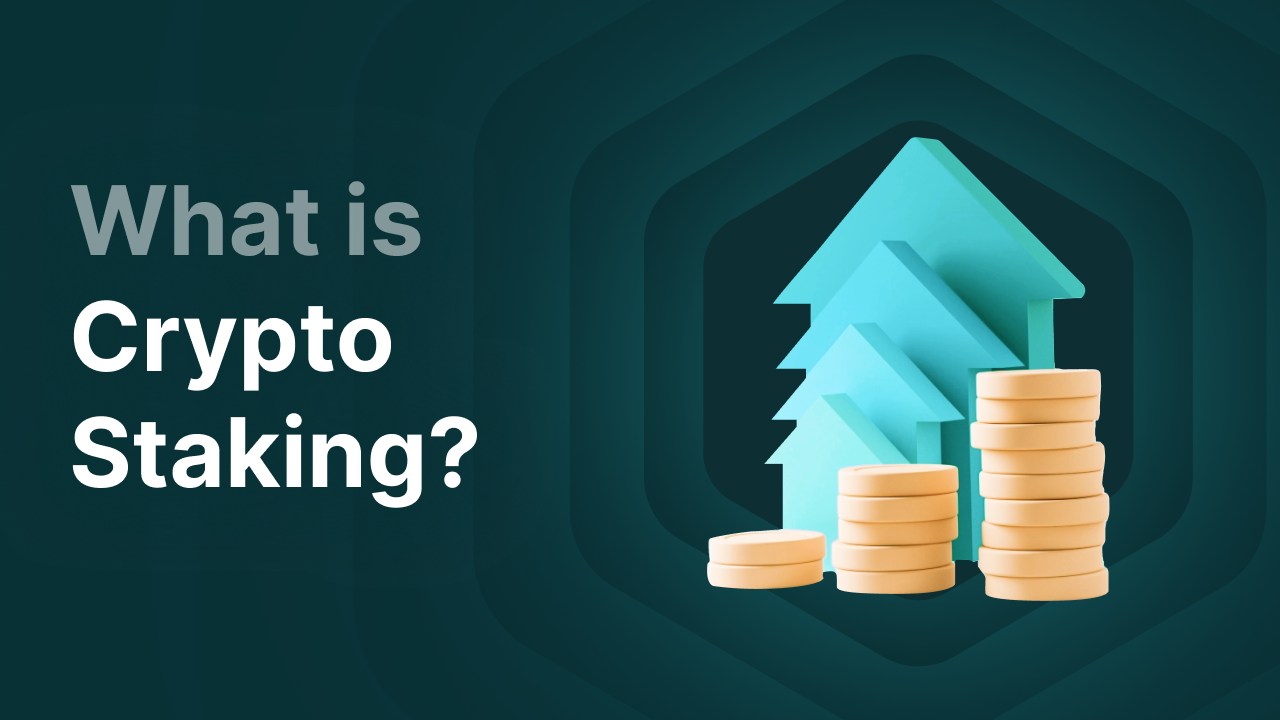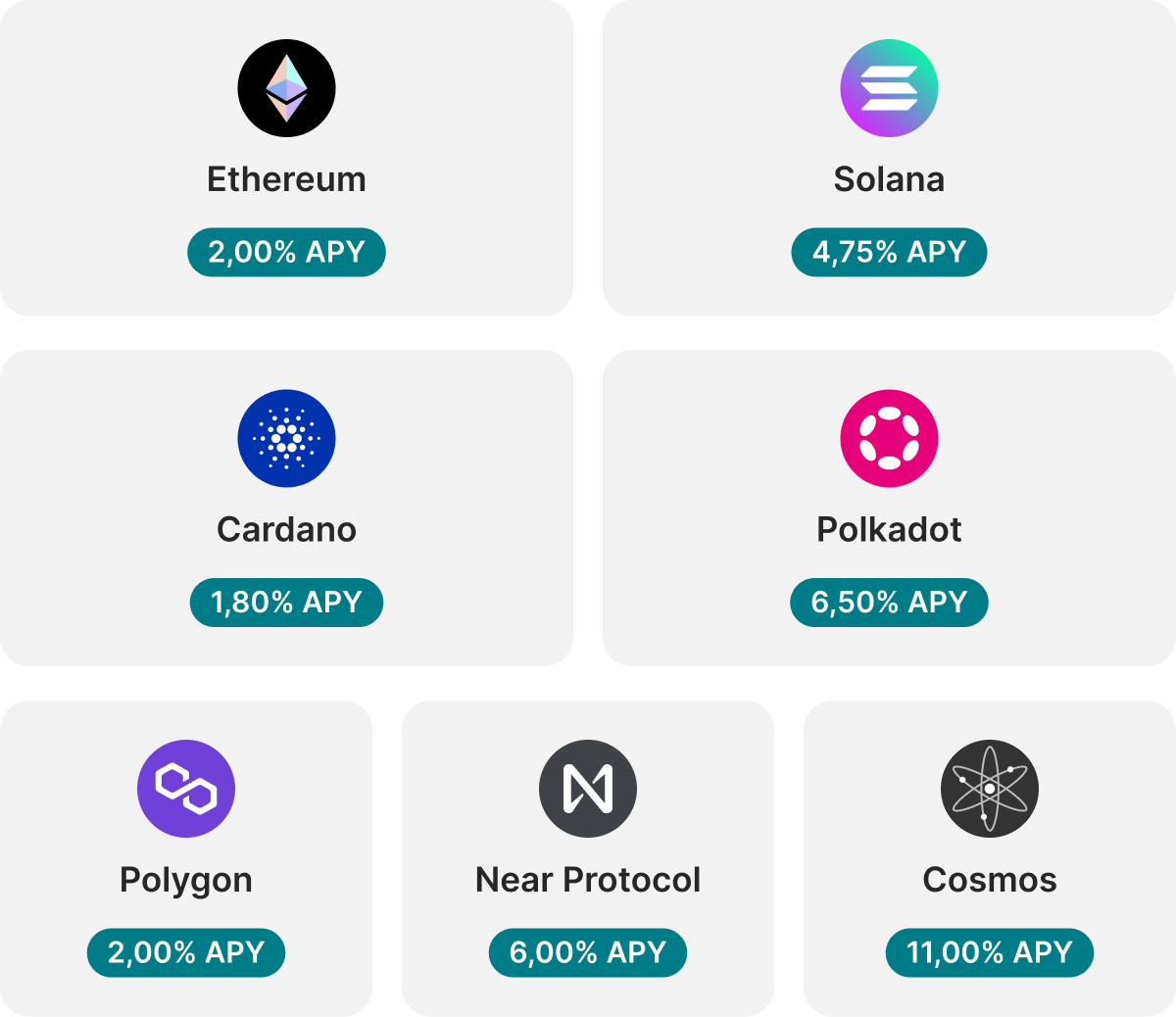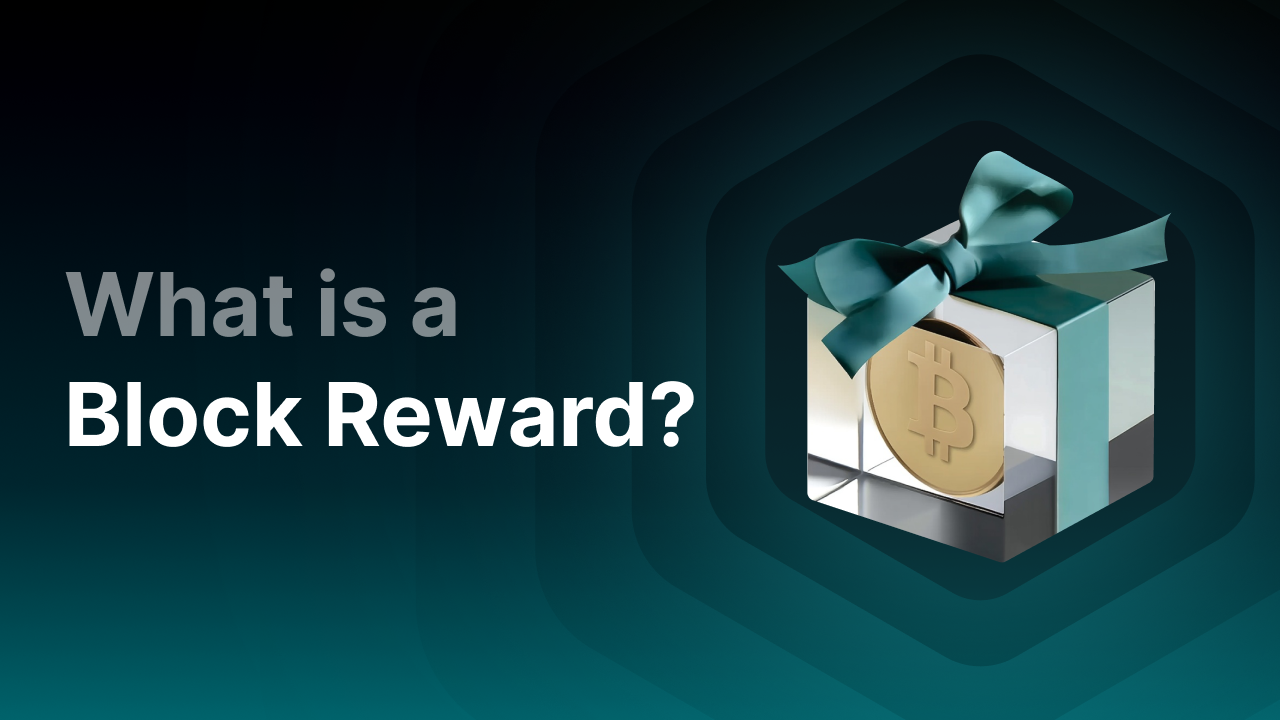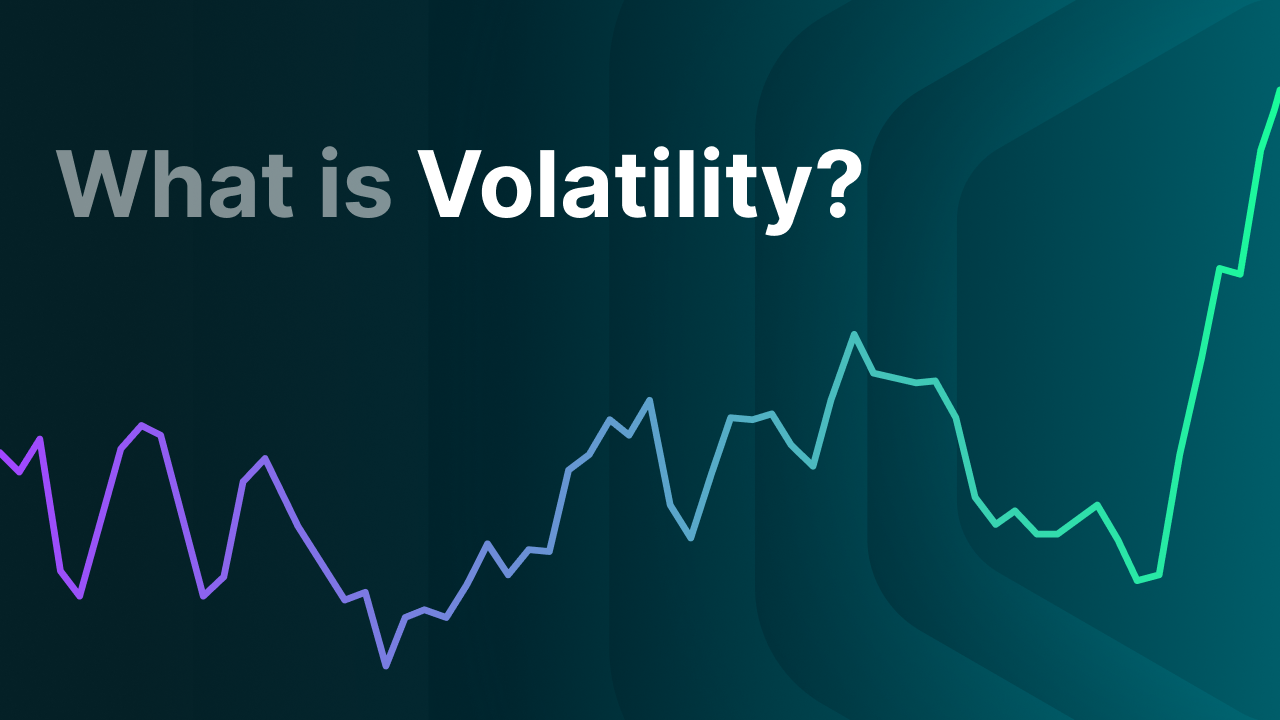What is crypto staking and how does it work?

What is crypto staking?
Crypto staking is a way to earn returns on your crypto by making it available to help secure the network. With staking, you earn passive income by supporting the network of a cryptocurrency like Ethereum, Solana, and Polygon with validating transactions, adding new blocks to the blockchain, and securing the network. For this work, you’re rewarded with new tokens. You don’t have to do much—just indicate that you want to stake your crypto.
You can think of it like a savings account. Typically, you deposit money into a savings account to earn interest. This is often a low percentage paid monthly or yearly—a reward for keeping your money with a specific bank. In reality, the bank lends your money to others (like mortgage holders) or invests it to generate additional income. The interest rate is a thank-you for allowing them to use your money.
Crypto staking is similar, except your crypto isn't lent out to others—it helps run the network. The major advantage over saving with a bank is that staking rewards are usually much higher than bank interest. However, cryptocurrency prices can be highly volatile. This means that rising prices can boost your income because your tokens are worth more. On the flip side, falling prices can quickly reduce the value of your crypto.
Key Takeaways
- Staking is a way to earn passive income by using crypto to validate transactions and earn rewards.
- There are several types of staking, like setting up your own validator node, staking pools, centralized platforms (like Finst), and liquid staking.
- Staking involves risks like price volatility, lock-up periods, slashing, and smart contract risks with liquid staking.
- Staking differs from lending: lending typically carries more risk because you loan your crypto to third parties. Staking is done via the network itself and is usually safer.
How does crypto staking work?
Crypto staking works via the Proof of Stake (PoS) consensus mechanism, or a variation of it. PoS is a process where validators are randomly selected to validate transactions and add them to a block. If a validator succeeds, they receive a reward in crypto. Anyone can participate and act as a validator, which keeps the network decentralized.
So, how do you become a validator? With PoS, you become a validator by staking your crypto. This means locking up your tokens for a certain period. This is called the lock-up period. During this period, you cannot trade or move your tokens. The length depends on the staking method. You may be able to lock tokens for a year, a month, or a week. Some staking methods have no lock-up at all, so you can sell or send your tokens at any time. The longer you lock your tokens, the higher the staking rewards. A higher staked amount also usually means more rewards. The network selects you more often to validate transactions because you have more to lose, and you're more likely to do a good job. Corrupt validators are penalized by having some or all of their tokens taken away.
Staking vs mining
Crypto staking is one way to validate transactions in a decentralized way. Another method (more widely known) is mining. Both validate transactions differently. Blockchains that use the consensus algorithm Proof of Work validate transactions through mining. The most well-known example is Bitcoin: an energy-intensive process where computers constantly try to solve complex equations. Whoever finds the solution first gets to validate transactions and confirm the block. This requires expensive hardware with a lot of power.
Staking works differently. Computers don't need to run 24/7, which saves energy. Instead, the blockchain uses tokens staked by validators. A single validator or a group is selected to validate transactions, making it much more efficient.
Ways to stake crypto
1. Direct staking as a validator by setting up your own node
Running your own node is the most technical option. You launch your own node (a fully independent validator) and actively participate in the blockchain network. This can earn you the highest staking rewards. The downside is that it requires technical knowledge and a high staking amount. For example, Ethereum requires 32 ETH. You also need to keep your server running at all times. If it fails, your node may be penalized through slashing.
2. Staking via a staking pool
A popular method is using staking pools. You lock your tokens and stake through another node. This requires little technical skill and usually no minimum stake. The downside is lower returns and less control over the staking pool.
How to join? You'll need a crypto wallet like Metamask, Keplr, or Ledger. These providers often offer tools to easily join a staking pool.
Tip: Research the staking pool’s reliability by checking online reputation, size, node decentralization (are there many participants?), and staking rewards (are they realistic or too good to be true?).
3. Staking via centralized platforms
Crypto exchanges often offer staking services—Finst included. The advantage of staking through a platform like Finst is ease: you can turn it on in settings and start earning passive income. You can also earn interest on multiple cryptocurrencies at once. However, decentralized platforms often offer higher returns.
4. Liquid staking
A newer method is liquid staking. You lock your tokens and earn rewards, but also receive a liquid token in return. This is a replacement token you can trade while staking. Your crypto remains liquid during the lock-up.
You can join liquid staking via liquid staking protocols—these are DeFi projects. One example is Lido. Built on Ethereum, it lets you stake ETH and receive stETH (Staked Ether) in return. The amount and value are roughly equal.
Example: Stake 0.1 ETH via a protocol like Lido or Rocket Pool, and you get about 0.1 stETH (Lido) or 0.1 rETH (Rocket Pool).
The benefit of liquid tokens is that you can use them in other DeFi strategies like lending or yield farming (putting crypto into liquidity pools), allowing you to maximize returns.
What happens if you trade your liquid tokens? If you sell them for something like USDC, the buyer gets the rights to the staked tokens. This prevents abuse. Your liquid token is like a proof of ownership.
Liquid staking is generally complex and best suited for experienced DeFi traders.
APY vs APR
Staking rewards are often shown as APY or APR. For example, staking Cardano might give 2.4% APY, while staking Ethereum might show 1.5% APR. The difference is simple.
APR stands for Annual Percentage Rate—your expected yearly interest.
Example: You stake 1 ETH with a 2.5% APR. After 1 year, you earn 0.025 ETH. So you end up with 1.025 ETH. These rewards are not automatically reinvested, so there's no compounding.
APY, or Annual Percentage Yield, includes compounding. Your rewards are reinvested, and you earn staking income on those as well—interest on interest!
The more frequently you're paid, the faster you earn on your rewards. Depending on the platform, payouts may be daily, weekly, or monthly.
Example: You stake 1 ETH with a 2.5% APY. After one year, you’ll earn a little over 0.025 ETH—about 0.0253 ETH. You end up with approximately 1.0253 ETH due to compounding.
What are the benefits of staking?
Crypto staking offers many benefits for both investors and the blockchain network:
- Investors can easily earn extra income on their crypto with minimal technical knowledge.
- Unlike mining, staking doesn’t require expensive hardware. A phone with internet is enough.
- Staking helps secure blockchains, validate transactions, and supports decentralization.
Risks of crypto staking
Naturally, there are also risks associated with crypto staking. Below are the main risks summarized:
- Lock-up periods temporarily prevent you from doing anything with your crypto. Combined with the volatile market, this means you can’t sell your tokens, which can lead to significant losses.
- Malicious validators can cause you to lose a portion of your staked tokens due to slashing. Always make sure to choose a trustworthy staking pool!
- With liquid staking, there is always a risk of bugs in the smart contracts. Liquid staking protocols are built using smart contracts. If hackers or exploits discover vulnerabilities in the code, this can lead to the loss of your tokens.
Crypto staking with Finst
Finst offers highly competitive and flexible staking options for your crypto. You can stake your crypto easily, safely, and hassle-free with Finst.
With staking at Finst, you benefit from:
- Weekly payouts of your rewards, allowing you to earn compound interest.
- No minimum amount required for staking.
- No lock-up periods at Finst, meaning you can sell or send your crypto at any time.
- Enable staking with just one click in the Finst app.

Difference between staking and lending
Staking and lending are often confused. Both are ways to earn passive income with your crypto—but in different ways.
With staking, you use your tokens to help secure the network and validate transactions. With lending, you loan your crypto to others in exchange for interest. You’re essentially acting like a bank. This lending is done via smart contracts or centralized platforms. You agree on an interest rate that the borrower accepts.
Lending usually involves a middleman, like a centralized platform, and always relies on a party that must repay you. This is a key difference from staking. On-chain staking is executed directly via the blockchain, whether you manage it yourself or through a centralized platform. Payouts are handled automatically by the network, which makes them inherently reliable. Lending carries greater risk because borrowers must repay and have full control over your loaned crypto. You're more dependent on their decisions and financial stability. On the flip side, lending often offers higher returns.
There are few, if any, major scandals linked to staking. Lending is a different story. Multiple high-profile cases have caused major losses for investors in Europe and beyond. Notable examples include:
- Celsius Network
- BlockFi
- FTX – Alameda Research
All three misused customer funds or made poor, irrational investment decisions. Billions in client assets were lost, resulting in major reputational damage.
Final Thoughts
Crypto staking is an accessible way to earn passive income with your crypto, without the high costs and complexity of mining. Whether you choose to stake directly, use a staking pool, a platform like Finst, or opt for liquid staking, there are options for both beginners and experienced investors. It’s important to stay aware of the risks, such as price volatility, lock-ups, and technical vulnerabilities. Compared to lending, staking is generally safer, as rewards are distributed automatically by the network without a third party. By staying informed and choosing reliable platforms, you can responsibly get the most out of your crypto.




